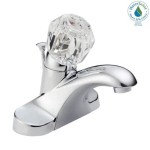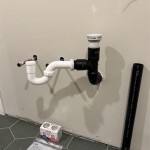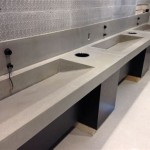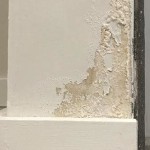Crane Bathroom Sink Replacement
Replacing a bathroom sink can significantly enhance the aesthetic appeal and functionality of a space. Crane, a well-established plumbing fixture manufacturer, offers a wide range of sinks known for their quality and durability. This article provides a comprehensive guide to replacing a Crane bathroom sink, outlining the necessary tools, materials, and steps involved.
Before embarking on the replacement process, gathering the required tools and materials is crucial. These typically include a basin wrench, adjustable wrench, channel-lock pliers, screwdriver set, putty knife, plumber's putty, silicone caulk, Teflon tape, bucket, towels, safety glasses, and work gloves. Additionally, having the new Crane sink, faucet, drain assembly, and supply lines readily available will streamline the installation.
The first step involves shutting off the water supply to the existing sink. Locate the shut-off valves under the sink and turn them clockwise until fully closed. Turning on the faucet confirms the water supply is completely off. Once the water is off, the drain needs to be disconnected. Place a bucket under the P-trap to catch any remaining water.
Disconnecting the P-trap involves loosening the slip nuts connecting the trap to the drain pipe and the sink tailpiece. A basin wrench or channel-lock pliers can assist in this process. After the P-trap is removed, the drain flange needs to be disconnected from the sink. This typically involves removing nuts located underneath the sink. Depending on the sink's installation, a putty knife might be required to loosen the old putty or caulk sealing the flange to the sink.
With the drain disconnected, the next step is to detach the water supply lines. Use an adjustable wrench to carefully loosen the nuts connecting the supply lines to the faucet tailpieces. Again, having a bucket handy is advisable to catch any remaining water in the lines. Once the water lines are disconnected, the sink can be removed from the countertop or vanity. If the sink is secured with clips underneath the counter, these will need to be loosened or removed to free the sink.
After removing the old sink, the countertop or vanity surface should be thoroughly cleaned to remove any residual putty, caulk, or debris. This ensures a clean and proper seal for the new sink. Once the surface is prepared, the new Crane sink can be installed. Depending on the sink model, the installation process may vary slightly. Consult the manufacturer's instructions provided with the sink for specific guidance.
Installing the new drain assembly is the next crucial step. Apply plumber's putty to the underside of the drain flange and insert it into the drain opening of the new sink. Tighten the nut from underneath the sink to secure the flange. Attach the tailpiece to the drain flange and connect the P-trap to the tailpiece and the drain pipe, tightening all connections securely.
Connecting the new faucet typically involves attaching the faucet to the sink from above, followed by securing it with nuts and washers underneath the sink. Flexible supply lines are then connected from the shut-off valves to the faucet tailpieces. Ensure all connections are tightened securely and apply Teflon tape to the threads of the supply lines to prevent leaks.
Once the faucet and drain are installed, turn the water supply back on slowly. Check for leaks around the drain, faucet connections, and supply lines. If any leaks are detected, tighten the connections or reapply Teflon tape as needed. Finally, apply a bead of silicone caulk around the perimeter of the sink where it meets the countertop to create a watertight seal and prevent water damage.
Replacing a Crane bathroom sink requires careful attention to detail and adherence to the manufacturer's instructions. While the process may appear complex, with the right tools and a systematic approach, homeowners can successfully complete this project and enjoy the benefits of a refreshed and functional bathroom space.
Understanding the specific requirements of the chosen Crane sink model is paramount for a successful installation. Consulting the manufacturer's instructions provides clarity on any unique steps or considerations specific to the chosen model. This ensures a smooth and problem-free installation process, preventing potential complications.
Regular maintenance of the newly installed Crane sink can prolong its lifespan and maintain its pristine appearance. Cleaning the sink with mild soap and water regularly prevents the buildup of grime and mineral deposits. Avoiding abrasive cleaners and scouring pads helps protect the sink's finish. Promptly addressing any minor leaks or issues can prevent more significant problems down the line.

1306v111 Crane Coronette Bathroom Sink 4 Centre White Amre Supply

1346v100 Crane Marquis Bathroom Sink 4 Centre Warm White Build Ca

1950 Vintage Crane Yorkshire Bathroom Sink Dea Machineries

1400v100 Crane Cranada Bathroom Sink 4 Centre Warm White Amre Supply

Henry Dreyfuss Designed Crane Sinks How To Tell If Yours Was Made Before Or After World War Ii Retro Renovation

Crane Drexel Wall Mounted Sink 1950s

How To Fix Crane Faucets Retro Renovation

American Standard Drop In Lavatory Coronette 21 X 17 White 1630004 020 Rona

1306v208 Crane Coronette Bathroom Sink 4 Centre Bone

Foremost Cairo Drop In Oval Lavatory Réno Dépôt
Related Posts







